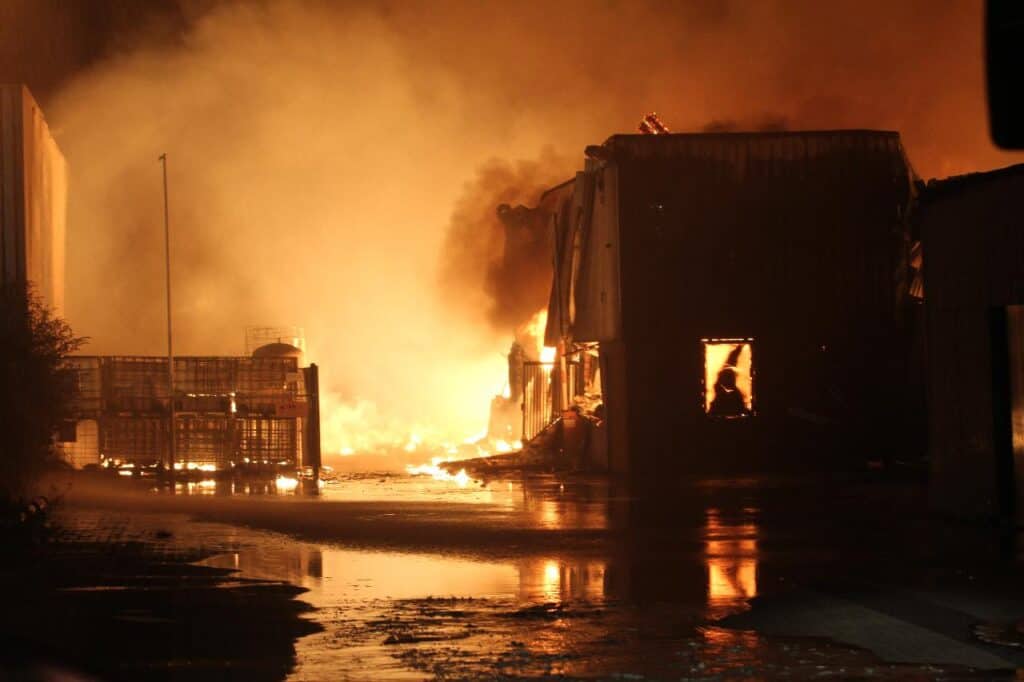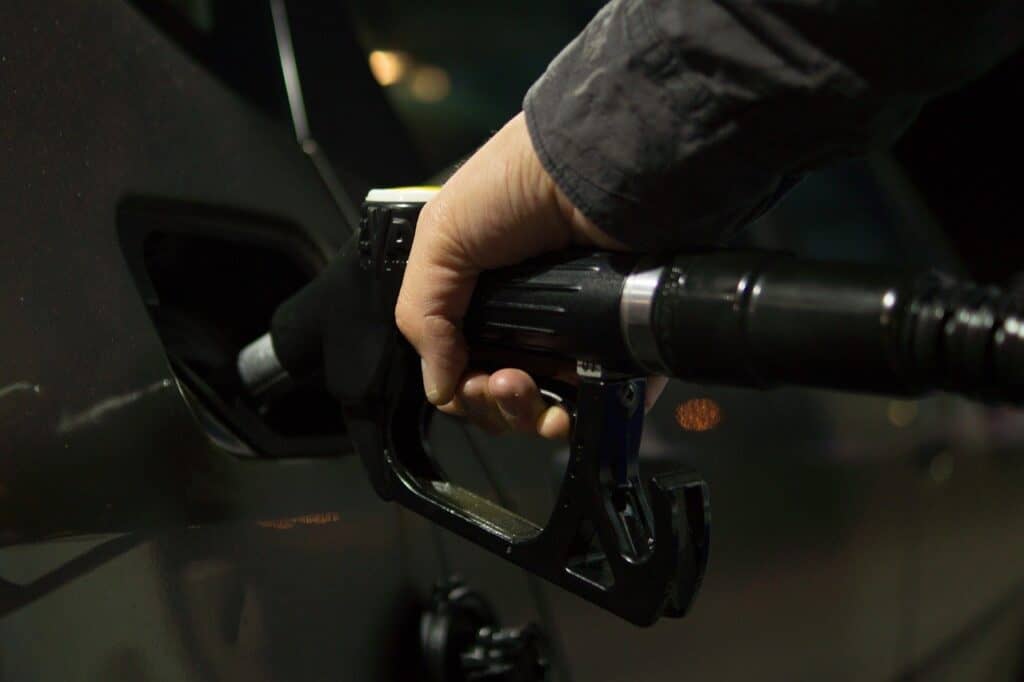Carbon monoxide is one of the most problematic gasses for humans. It is a common byproduct of fires and some household appliances such as boilers, furnaces, and heating systems. In large quantities, it is highly toxic to human beings, and it is one of the most prevalent causes of death in house fires. But does this mean that carbon monoxide is flammable and if so, how much risk does it bring?
Carbon monoxide is flammable and will burn as it has a flashpoint of -311.8 degrees Fahrenheit (-191 Celsius). This means it can catch fire well below most ambient temperatures.
While carbon monoxide can be a fire hazard in some situations, there are some other issues that you also need to know regarding its safety. Let’s take a closer look.
Your # 1 priority is keeping your family safe. As a firefighter, I recommend everyone has updated smoke detectors that don’t require battery changes, like these ones from Kidde, a fire extinguisher, like this one from Amerex, and a fire escape ladder if you have bedrooms above the first floor, I recommend this one from Hausse.
Also read: What Makes Something Flammable?
What Is Carbon Monoxide?

Carbon monoxide is a gas that is produced mainly, outside of laboratory situations, by the incomplete burning of carbon in oxygen.
Some biological processes also emit some carbon monoxide as a byproduct.
It is slightly lighter than air and if produced in the outdoors, it slowly rises and causes no real issues unless it is inhaled in large quantities.
Also read: Is Carbon Flammable? Why it Burns…
Where Is It Found?
In the main, carbon monoxide is found in fumes or smoke.
So, when cars and trucks burn fuel in their engines, carbon monoxide is part of the exhaust emissions. It’s also in the output of stoves, lanterns, fireplaces, gas ranges, frills, and furnaces.
It may also be generated in a house, office, warehouse, etc. fire. Really most any fire can produce CO.
Also read: Is Natural Gas Flammable? You May Be Suprised…
Can You Ignite Carbon Monoxide (Flammable)?
Carbon monoxide can ignite very easily because it is the result of the incomplete burning of carbon, it can be burned in oxygen to generate carbon dioxide.
Carbon monoxide is highly flammable, and it burns easily at temperatures far below the ceiling of 199.4 degrees Fahrenheit or 93 degrees Celsius.
This means that if you are using pure carbon monoxide it must be stored carefully and transported carefully too.
Typically, it is found in small quantities in the air and represents no major ignition risk but if it is allowed to build up, say in a burning building or due to a leak of carbon monoxide in a lab environment, then it becomes a substantial ignition risk.
Also read: Is Carbon Dioxide Flammable? (CO2)
Flash Point
The flashpoint of carbon monoxide is -191 degrees Celsius or – 311.8 degrees Fahrenheit. This is one of the reasons that it can be such a fire hazard. The temperature at which it can ignite with a spark is well below the temperatures we find in our normal life.
Does It Spontaneously Combust?
While carbon monoxide will burn in oxygen with almost no effort whatsoever, it doesn’t auto-ignite particularly easily.
In fact, it requires a temperature of 609 degrees Celsius or 1128 degrees Fahrenheit.
This is substantially hotter than in most environments and carbon monoxide is only like to spontaneously combust in a fire, by which time the flames would almost certainly have ignited the gas anyway.
Can A CO Leak Explode?
A carbon monoxide leak is very unlikely to explode.
While theoretically, it’s possible that it could build up in an enclosed space without catching fire, the odds are overwhelmingly in favor of it catching fire long before it explodes.
This doesn’t mean that a carbon monoxide leak is safe, mind you, it is a minor fire risk but a major health hazard.
Is Carbon Monoxide Toxic To Humans?
Carbon monoxide is potentially highly toxic to human beings.
The gas will happily bind itself to the oxygen receptors in our red blood cells. (Then called carboxyhemoglobin).
Unfortunately, unlike oxygen, which is an essential fuel in our bodies, it won’t unbind once it is present.
This makes it impossible for the cell to transport oxygen around your body.
In small quantities, this doesn’t matter.
We carry a huge surplus of blood cells, and they die off and are replenished with astonishing regularity.
However, if you are exposed to large amounts of carbon monoxide, you will eventually asphyxiate and unlike with exposure to other gasses such as carbon dioxide, moving outside will not help you if you are asphyxiating on carbon monoxide.
Changing the air in your lungs, unfortunately, can’t undo the harm that carbon monoxide has done to the blood cells.
This means that carbon monoxide, particularly that generated from household heating systems, but also from fires, etc. causes death and injury on a regular basis.
In fact, in a typical year, in the United States, more than 400 people die from carbon monoxide poisoning and over 50,000 are admitted to hospital with serious injuries due to carbon monoxide poisoning.
Carbon monoxide is a “silent killer” and because it mimics the action of oxygen in the blood, your body doesn’t panic when you breathe carbon monoxide (which it does with other forms of asphyxiation) and many people with carbon monoxide poisoning die in their sleep.
This is the reason a Carbon Monoxide detector is so important to have in all homes and offices. It can literally save your life, as it has for many people. Here is the type I recommend. Well worth the price for the difference it could make. And don’t forget to change the batteries.
Also read: Is Ozone Flammable? No, But It is a Fire Hazard…
Can Carbon Monoxide Kill Pets?
Yes, carbon monoxide is as much of an issue for pets as it is for human beings, and for exactly the same reason – it prevents oxygen from being transported around their bodies resulting in their asphyxiation.
How Do I Know If My Furnace Is Leaking Carbon Monoxide?
If you’re worried that your furnace isn’t up to standard and could be leaking carbon monoxide, you might want to consider:
- The age of the furnace – the older they get, the more likely they are to have problems, a furnace that is older than 20 years should be replaced.
- Rising gas and electric bills – if your furnace isn’t burning fuel properly, it will use more fuel.
- Does your furnace break down often? If so, it might be time to replace it.
- Is the temperature on your thermostat providing the right level of warmth? A broken furnace doesn’t heat up well enough.
- Is the burner flame yellow? This is a huge warning sign that your furnace is producing carbon monoxide, if this is the case seek an opinion from a professional immediately.
- Do you or your family have regular flu or headache symptoms? This is often an indication of mild carbon monoxide poisoning.
The only real, safe way to know if you have a leak is to consult a professional. Well worth it.
How Can You Tell If There Is Carbon Monoxide In Your House?
Since it is odorless, colorless, and tasteless, the only way to know if carbon monoxide is present is with a detector.
The best way to tell if you have carbon monoxide issues in your home is to buy a carbon monoxide detector (or more than one, depending on the size of your home, check the manufacturer’s instructions to see how many you need).
This is a simple device that monitors the air and if carbon monoxide is detected in sufficient quantity, it emits an audible alarm designed to wake you (and anyone else) and ensure that you can get to safety.
Carbon monoxide detectors are not expensive, and everyone should have one in their home as it can mean the difference between life and death for you and your family.
What Do 3/5 Beeps Mean On A Carbon Monoxide Detector?
If your carbon monoxide detector is shrieking an alarm, get out and get to a well-ventilated area and then consult a professional regarding the source of the carbon monoxide.
However, 3 beeps usually means that your carbon monoxide detector is malfunctioning and needs to be repaired or replaced.
5 beeps usually means that the carbon monoxide detector has reached the end of its useful life and must be replaced.
Note: These may vary by manufacturer, age, and type.
If you are ever unsure, get out of the house, call 911 (or other emergency number) and wait for responders to come to ensure it is safe.
Can Dogs Smell CO?
We’ve heard some bizarre rumors on the internet that dogs can help smell out carbon monoxide and we want to point out this is completely false.
At least there is no credible proof that they can.
Carbon monoxide is 100% odorless for all animals and human beings and you cannot rely on your family pet to sound the alarm in the event of carbon monoxide build-up; you must buy a carbon monoxide alarm.
Is Carbon Monoxide Bad For The Earth?
Carbon monoxide is not a greenhouse gas per see, but carbon monoxide in the air reflects the presence of carbon dioxide and methane and these are greenhouse gasses.
So, while carbon monoxide is not bad for the earth, its presence in the atmosphere is a warning sign all the same.
Sources
1, 2, 3, 4, 5, 6, 7, 8, 9, 10, 11, 12, 13, 14, 15
Related Articles
How Do Firefighters Check for Carbon Monoxide (CO)?

